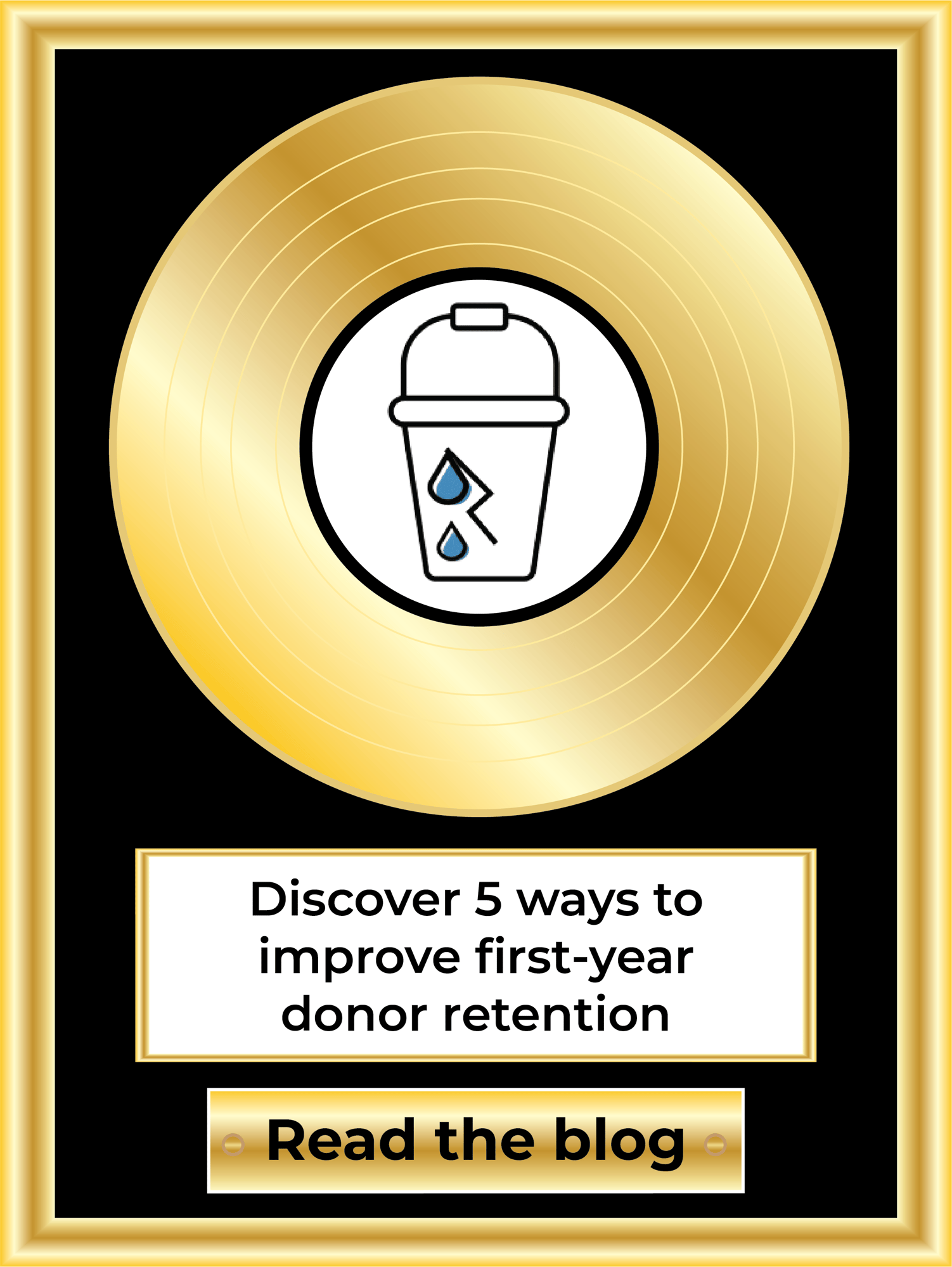The Skinny
Ah, the 1970s. The age of disco and funk, bell bottoms, smiley faces and those new things called computers. Culturally, it was a time of "far out" social consciousness and self-expression. Politically, it was a time of turmoil.
Between the Vietnam War and the Watergate scandal, Americans had lost their trust in "the man" by the end of the decade. At the same time, nonprofit organizations were really beginning to boogie.
By the Seventies, nonprofits were emerging in new relevance. The Tax Reform Act of 1969 gave us the Section 501(c)(3) in the Internal Revenue Service Code, which provides legal status for charitable organizations to offer tax exemptions to donors. This ushered in an official "nonprofit sector" and prompted organizations to take a groovier approach to fundraising.
We're not saying that nonprofit marketing was all good vibes back in the day. It's easy to look back at any time with rose-colored glasses.
But times have changed. People have changed. And here's the lowdown: Trust is the single most important thing that a nonprofit can deliver. It is truly solid gold.
Today, we find that trust in nonprofits is declining. In 2022, the nonprofit industry was still ahead of government in the annual Edelman Trust Barometer rankings. In the last year we have taken a step back, falling behind business in trustworthiness for the first time in the report's history.
Trust is the single most important thing that a nonprofit can deliver.
It is truly solid gold.
Only 59 percent of respondents said nonprofits can be trusted "to do what is right." That means that 41 percent have little faith in these institutions who are committed to making the world more humane, just and compassionate.
How did we get here? And how can nonprofit organizations build trust with donors going forward?
Executive Summary
Trust is such a simple and complex word all at once. In a sense, it's just "doing what you say you're going to do." When the outcome continually matches the expectation, trust is formed.
But there are oh-so-many layers that complicate this basic definition. And one slip-up along the path can reset that trust back to zero.
RKD Group chose to explore these layers to gain a deeper understanding of what drives the spectrum of donor trust in nonprofit organizations. We commissioned McQueen Mackin and Associates to conduct a research study, asking donors a wide range of questions around the topic of trust in nonprofits.
Our findings are—like trust itself—both simple and complex.
The primary driving forces in building trust are transparency and competence. Donors indicated that they want to understand a nonprofit's plans to achieve their mission - and then see reports on how their dollar is being used to reach those goals.
Seems simple enough.
But the complexity comes in how donors want to receive information about these plans and the data on execution. It has to be on their terms. In their wheelhouse. The way they want it, or it's not their scene.
Communication preferences, belief in the cause and personality differences all come into play—some of which are evident in previous research we've published.
In 2021, we examined the differences among generations and how they support nonprofits. In 2022, we studied what defines a strong relationship with a nonprofit from the donor's point of view.
We implemented questions in this research project to examine the effect of the donor's generational cohort and their relationship with an organization on trust. Surprisingly, a donor's generation had little impact on trust, yet we share below some differences that stood out across generations.
Even more complex is the connection between trust and relationship depth. The findings show that donors can have a high level of trust in a nonprofit without having a strong relationship with the organization.
We examined factors like the type of nonprofit, positive/negative experiences with a nonprofit, familiarity with their capabilities as well as whether thinking about a specific nonprofit makes a difference.
Finally, it's important to note the impact that trust has on charitable giving. Higher trust leads to more years of donating to an organization.
This, in turn, leads to a higher lifetime value for high-trust donors.
That means that trust is truly worth its weight in gold.
How We Asked
The data in this report comes from an online survey of 1,630 U.S. donors, commissioned by RKD Group. This study was conducted across April and May 2023 by McQueen Mackin and Associates, a market research firm that is dedicated to the research and data that drive psychology and human behavior.
Survey respondents make up a nationally representative sample of people who gave at least $25 in the previous calendar year (excluding place of worship). The survey was controlled for sex (42% men, 58% women) and age (10% Generation Z, 27% Millennial, 29% Generation X and 34% Baby Boomer). Additional controls were put in place to ensure that inaccurate and invalid responses were excluded.
We asked survey respondents a series of questions regarding their trust in nonprofit organizations. The aim was to uncover:
Three trust segments:
Low (scores 1-5)
Mid (scores 6-8)
High (scores 9-10)
- The trust (or lack thereof) between donors and different types of nonprofits
- What makes a nonprofit more trustworthy?
- What makes a nonprofit more transparent?
- How people rate trustworthy nonprofits vs. those they find less trustworthy
- Generational differences across areas
Respondents were then asked to name two specific nonprofit organizations—one they consider "very trustworthy" and one they feel is not as trustworthy as others. They were randomly given one of the two organizations to answer another series of questions specifically about that one nonprofit.
Respondents were asked to rate their trust of the one nonprofit on a scale of 1-to-10. Based on the "trust score" they gave to the nonprofit they were randomly assigned, each respondent was classified into one of three segments: Low (scores 1-5), Mid (scores 6-8) and High (scores 9-10).
Throughout this study, we used these segments to analyze the spectrum of trust,
Transparency and competence drive trust in nonprofits
Transparency and competence are the primary drivers of trust in nonprofit organizations—which makes sense.
Transparency has always had a unique place in the nonprofit space. After all, you wouldn't expect a private business to detail where it spends all its revenue, would you? Yet that's what is required of nonprofits.
So, you need to be honest and open, but you also need to be able to actually do what you say. If you don't have what it takes to do what's been promised, trust will quickly erode.
In the chart below, we see that donors who rated nonprofits "high" on the trust scale want to see clear accomplishments, real data and relevant facts. And there is little difference from one generation to the next on the impact of each driver.
Donors simply want nonprofits to do three things:
- Tell me what you plan to do
- Do what you say you're doing to do
- Show how my donation helps you do it
That may seem pretty straightforward, but it's not as easy to accomplish as it may seem.
Note that Gen Z is slightly less interested in impact data and explanations and that older generations are slightly less interested in being involved through volunteering or giving feedback.
Preferences matter—so pay attention to those details.
Communication also clearly plays a big role here, but it has to be done on the donor's terms.
Only 4 out of 10 respondents identified that nonprofits had asked for their perspective. It can be challenging to communicate with someone on their terms if you don't know what those terms are.
When we break it down by frequency of communication, we see that more communication is connected to higher levels of trust.
As we dug a little deeper into transparency, we found a few key drivers that stood out:
- An understanding of how nonprofits use their donation funds
- The ease of access of information about how funds are used
- A level of authenticity into what's happening at the organization
It would be easy to chalk this up to another study that reveals the value of stewardship or impact reports. If that's your conclusion, well, you may have missed the point. Simply increasing the amount of stuff you send to someone does not mean they consumer, comprehend or truly contemplate the information.
This is deeper—because trust is a deep, assured reliance on the character, ability, strength or trust of someone or something. The findings reveal and reiterate that a nonprofit's priority should be to communicate to its donors with transparency.
There's a reason why some impact reports are successful and others are not. Those that are clear, transparent about success and failure, those that explain the challenges faced and the facts that affected the decisions made are those that will win the hearts of donors.
Another key factor driving trust is belief, both in the mission itself and—note this—in the organization's ability to accomplish the mission.
In the chart below, we see the biggest gaps between high-trust and low-trust organizations occur in the personal belief of the respondent: whether the nonprofit organization garners respect of pride, whether the respondent would personally recommend them or if the org aligns with their values.
Less important drivers are those that are farther removed from the personal belief—like whether the org has a strong brand presence and is respected in the nonprofit space.
Generational differences affect who is trusted
It's clear what drives greater trust in nonprofits, so let's dig deeper into the who—who is trusted more and who is more trusting. As we uncovered, those two factors are related.
Respondents rated small business (7.1) as slightly more trustworthy than nonprofits (7.0) on a 10-point scale. Then, there was a wide gap before large corporations (5.0) ranked just ahead of government agencies (4.9) and government leaders (4.5).
Across generations, these numbers were relatively similar. Each organizational group was rated slightly lower by older generations.
This gives more clarity to the perception within the sector on the findings of the aforementioned Edelman Trust Barometer. No, Google and Amazon are not trusted more than a local food bank.
This shows the relative balance of trust that impact organizations have. Small businesses and nonprofits are both, generally speaking, community oriented. Remember, trust is higher where greater impact is seen by the contributor.
When we isolated nonprofit organizations and broke them down by the scope of where they serve, there were some differences among the age groups.
Building on this idea of community, local organizations were the most trusted across the board, rating a 7.4 or 7.5 across each generation. National organizations came in second and were slightly more trusted by the two younger generations.
International organizations. ranked lowest among the three groups, driven by lower scores among Gen Xers and Baby Boomers. This mirrors our Gen X research, which found that younger donors—who grew up with wider access to the internet and social media—were more likely to support global causes.
Likewise, we see that Gen Zers and Millennials gave to international organizations more than Gen Xers and Boomers. Gen Xers gave to local organizations more than other generations, and Boomers donated to national organizations more than other generations.
Breaking this down further into different sectors across the nonprofit industry, we again see generational differences in trust.
Social and human service organizations received the highest amount of trust at 7.4, and this was consistent across the generations. Animal welfare, disaster relief, hospital foundations, child service organizations, and health and disease research organizations also saw consistent support across different age groups.
Veteran and military organizations as well as faith-based organizations saw higher levels of trust among Gen X and Boomers. Educational support, environmental organizations and groups fighting for social and racial justice saw higher levels of trust among Gen Z and Millennials.
Political policy organizations and political candidates also saw slightly higher levels of trust among younger generations, but support was clearly the lowest across the board.
Demography is just one dimension to think about donors. It's nifty, but it doesn't tell the whole story. What we take from this information is that donors, while unique, have some broadly consistent ideas when it comes to how they think about trust and giving.
Learning who your donors are truly matters—so that you can both localize your impact and communicate on their terms.
Trust not strongly affected by personal connection
Our Listen Up research examined what drives stronger relationships between donors and the organizations they support. We found that feeling valued and included were the two biggest drivers.
Relationships are seemingly the heartbeat of the nonprofit marketing and fundraising sector. And for good reason. We exist in an age of connection.
Relationships, like trust, are on a spectrum. And when it comes to trust, personal relationships matter but aren't the most important thing to focus on.
Read that again.
When it comes to trust, personal relationships matter but aren't the most important thing. We asked respondents to rank both their relationship with and their trust in one particular nonprofit organization.
The results for trust:
- 47% high
- 24% mid
- 29% low
- 26% high
- 45% mid
- 29% low
It's clear that donors can have high trust in a nonprofit organization without having a strong relationship with them. That's because what drives trust is different from what drives relationships. In other words, you can build trust without becoming BFFs.
Being high-trust matters.
When you are high-trust, you can then focus on the relative depth of relationships that your donors crave (or not).
About the Researchers
About RKD Group
RKD Group is a leading fundraising and marketing services provider to hundreds of growth-focused nonprofit organizations. With five decades of experience, RKD leverages technology, advanced data science and award-winning strategic and creative leadership to accelerate net revenue growth, build long-term donor relationships and drive the best return on investment.
About McQueen Mackin and Associates
Using market research to provide insights into how to best ignite donor passions, McQueen Mackin and Associates helps nonprofit organizations raise more funds to further their cause and do more good in the world. Through years of experience and countless research projects, McQueen Mackin has developed numerous tools and models they have put to use for many nonprofits like the National Park Foundation, Susan G. Komen, The Salvation Army, St. Jude Chilren's Research Hospital and more. For additional information, visit mcqma.com.





